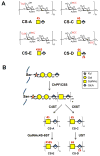Sugar-dependent modulation of neuronal development, regeneration, and plasticity by chondroitin sulfate proteoglycans
- PMID: 26315937
- PMCID: PMC4679498
- DOI: 10.1016/j.expneurol.2015.08.015
Sugar-dependent modulation of neuronal development, regeneration, and plasticity by chondroitin sulfate proteoglycans
Abstract
Chondroitin sulfate proteoglycans (CSPGs) play important roles in the developing and mature nervous system, where they guide axons, maintain stable connections, restrict synaptic plasticity, and prevent axon regeneration following CNS injury. The chondroitin sulfate glycosaminoglycan (CS GAG) chains that decorate CSPGs are essential for their functions. Through these sugar chains, CSPGs are able to bind and regulate the activity of a diverse range of proteins. CSPGs have been found both to promote and inhibit neuronal growth. They can promote neurite outgrowth by binding to various growth factors such as midkine (MK), pleiotrophin (PTN), brain-derived neurotrophic factor (BDNF) and other neurotrophin family members. CSPGs can also inhibit neuronal growth and limit plasticity by interacting with transmembrane receptors such as protein tyrosine phosphatase σ (PTPσ), leukocyte common antigen-related (LAR) receptor protein tyrosine phosphatase, and the Nogo receptors 1 and 3 (NgR1 and NgR3). These CS-protein interactions depend on specific sulfation patterns within the CS GAG chains, and accordingly, particular CS sulfation motifs are upregulated during development, in the mature nervous system, and in response to CNS injury. Thus, spatiotemporal regulation of CS GAG biosynthesis may provide an important mechanism to control the functions of CSPGs and to modulate intracellular signaling pathways. Here, we will discuss these sulfation-dependent processes and highlight how the CS sugars on CSPGs contribute to neuronal growth, axon guidance, and plasticity in the nervous system.
Keywords: Axon guidance; Axon regeneration; CSPG; CSPG receptor; Chondroitin sulfate (CS); Glycosaminoglycans; Neuronal growth; Neuronal injury; Plasticity; Proteoglycan.
Copyright © 2015 Elsevier Inc. All rights reserved.
Figures


Similar articles
-
Mechanisms for modulation of neural plasticity and axon regeneration by chondroitin sulphate.J Biochem. 2015 Jan;157(1):13-22. doi: 10.1093/jb/mvu067. Epub 2014 Nov 6. J Biochem. 2015. PMID: 25381371 Review.
-
Chondroitin sulfate proteoglycans: Key modulators in the developing and pathologic central nervous system.Exp Neurol. 2015 Jul;269:169-87. doi: 10.1016/j.expneurol.2015.04.006. Epub 2015 Apr 18. Exp Neurol. 2015. PMID: 25900055 Review.
-
Modulation of Receptor Protein Tyrosine Phosphatase Sigma Increases Chondroitin Sulfate Proteoglycan Degradation through Cathepsin B Secretion to Enhance Axon Outgrowth.J Neurosci. 2018 Jun 6;38(23):5399-5414. doi: 10.1523/JNEUROSCI.3214-17.2018. Epub 2018 May 14. J Neurosci. 2018. PMID: 29760175 Free PMC article.
-
[Chondroitin sulfate proteoglycans in neural development and regeneration].Sheng Li Ke Xue Jin Zhan. 2007 Apr;38(2):101-5. Sheng Li Ke Xue Jin Zhan. 2007. PMID: 17633220 Review. Chinese.
-
Regulation of autophagy by inhibitory CSPG interactions with receptor PTPσ and its impact on plasticity and regeneration after spinal cord injury.Exp Neurol. 2020 Jun;328:113276. doi: 10.1016/j.expneurol.2020.113276. Epub 2020 Mar 4. Exp Neurol. 2020. PMID: 32145250 Free PMC article. Review.
Cited by
-
Development of an in vitro intervertebral disc innervation model to screen neuroinhibitory biomaterials.J Orthop Res. 2020 May;38(5):1016-1026. doi: 10.1002/jor.24557. Epub 2019 Dec 19. J Orthop Res. 2020. PMID: 31825104 Free PMC article.
-
Focal clusters of peri-synaptic matrix contribute to activity-dependent plasticity and memory in mice.Cell Rep. 2024 May 28;43(5):114112. doi: 10.1016/j.celrep.2024.114112. Epub 2024 Apr 26. Cell Rep. 2024. PMID: 38676925 Free PMC article.
-
Chondroitin sulfate protects against synaptic impairment caused by fluorosis through the Erk1/2-MMP-9 signaling pathway.Sci Rep. 2025 Aug 13;15(1):29760. doi: 10.1038/s41598-025-14631-7. Sci Rep. 2025. PMID: 40804089 Free PMC article.
-
Proteoglycans in Biomedicine: Resurgence of an Underexploited Class of ECM Molecules.Front Pharmacol. 2020 Jan 29;10:1661. doi: 10.3389/fphar.2019.01661. eCollection 2019. Front Pharmacol. 2020. PMID: 32082161 Free PMC article. Review.
-
Pharmacological intervention for chronic phase of spinal cord injury.Neural Regen Res. 2025 May 1;20(5):1377-1389. doi: 10.4103/NRR.NRR-D-24-00176. Epub 2024 Jun 26. Neural Regen Res. 2025. PMID: 38934397 Free PMC article.
References
-
- Bao X, Nishimura S, Mikami T, Yamada S, Itoh N, Sugahara K. Chondroitin sulfate/dermatan sulfate hybrid chains from embryonic pig brain, which contain a higher proportion of L-iduronic acid than those from adult pig brain, exhibit neuritogenic and growth factor binding activities. J Biol Chem. 2004;279:9765–9776. - PubMed
-
- Bao X, Mikami T, Yamada S, Faissner A, Muramatsu T, Sugahara K. Heparin-binding growth factor, pleiotrophin, mediates neuritogenic activity of embryonic pig brain-derived chondroitin sulfate/dermatan sulfate hybrid chains. J Biol Chem. 2005;280:9180–9191. - PubMed
-
- Bartus K, James ND, Bosch KD, Bradbury EJ. Chondroitin sulphate proteoglycans: key modulators of spinal cord and brain plasticity. Exp Neurol. 2012;235:5–17. - PubMed
Publication types
MeSH terms
Substances
Grants and funding
LinkOut - more resources
Full Text Sources
Other Literature Sources
Research Materials
Miscellaneous

